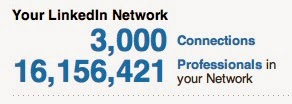Thursday, May 29, 2014
Thursday, May 22, 2014
Linkedin Status May 2014
This is my Linkedin network status as at 22 May 2014
What started out as a twiddle-thumb exercise to keep warm while waiting for the DemoAsia 2012 show to start in February 2012 turned into an exciting journey. I had less than 100 connections then. By the end of the DemoAsia 2012 event I think I had doubled that.
I was hooked and made it a point to see how far I can make connections.
Linkedin decided to boost the egos of its members with a status of profile-view statistics. This was my Linkedin network experiment status in Jan 2013.
Quite fun, this connecting-up thing.
Within this network are colleagues, friends, acquaintances, and people I have not met but are willing to share. They are largely in the technology commercialisation value chain. Angels, VCs, investors, accelerators, incubators, consultants, entrepreneurs, programmers, students, solutions providers, systems integrators, media and advertising industry buyers, go-to-market consultants, contract engineering consultants... This outreach is expanding as people in the network discover even more like-minded colleagues.
It is my wish that you are a part of this community, that you are sincere, that you can find help, and that you can help others in return.
Enjoy
Saturday, May 17, 2014
Wednesday, May 7, 2014
Monday, May 5, 2014
Speech & Language Innovation Cluster Program Manager
Speech & Language Innovation Cluster Programme Manager – Job Description
The candidate will work closely with A*STAR’s Institute for Infocomm Research (I2R) to manage an ETPL-funded programme to develop and integrate I2R’s technologies in speech and language processing for cloud-deployable web services.
The scope of work would include but may not be limited to:
- Manage the Speech & Language Innovation Cluster (SLIC) programme to drive projects under this programme towards the fulfillment of specified technical milestones and commercial outcomes. As a part of project management, the candidate will oversee the project development and technology implementation, and track and control all project phases and activities. This would include the management of manpower, resources, external consultants, vendors and other functions relating to the project.
- Drive and implement a startup business plan and its formation with investors, eco-system partners, and prospective customers.
Requirements:
- A Bachelor’s Degree in the area of Electrical and Electronics Engineering, Computer Science, Computer Engineering, or equivalent;
- 8 years of industrial experience in business development, project management or product management in the software industry, preferably in the applications of speech & languages;
- A good understanding of current and future trends of speech and languages technologies;
- Working knowledge of or experience in the application of the following technologies to various verticals is preferred: web services, cloud-based deployment, speech recognition, speech synthesis, voice biometrics, text-based language translation;
- Effective presentation, excellent verbal and written communication skills;
- Able to lead a team and possess strong interpersonal skills.
- Relevant enterprise sales and business development track record preferred.
d Links:
Human Language Department:
Speech Recognition (ASR): Converts spoken speech to text
Speech2Singing: Converts reading of song lyrics to singing of song lyrics
Voice Biometrics (VB): Using voice profiles as access control
Speech Synthesis (TTS): Converts text into synthesised speech
Text translation (MT): Translates text in one language to another language
Multilingual Chat: Chat application which lets you chat in your own language and the other party receives the chat in his/her own language
Friday, May 2, 2014
ETPL Challenge @ Hackathon Startup Asia 2014
http://startupasia.techinasia.com/sg2014/hackathon/
Register
Background
One of the key industries that Singapore has been developing is MICE (Meetings, incentives, conferences, and exhibitions). There are many events being held in the country throughout the year and how well the event organisers manage the events and the overall experience the delegates derived from the events would contribute to the overall success of the industry. However, as the frequency and number of events and attendees increases, the industry players specifically the event organisers are faced with new challenges in bringing good and seamless experience to the participants (attendees, sponsors, speakers and exhibitors).
Problems
With the number of events increases, event participants are faced with increased competitions from event organisers for their attention and participation. Unfortunately, quite a number of events are of the same nature and it becomes difficult for the participants to decide which events to attend. In addition, they received these advertising through multiple online and offline channels providing duplicated information.
At the event, attendees are faced with unpleasant experience in long waits during on-site registrations, collection of event passes and the need to update inaccurate registration details. Though event organisers may have deployed many staff at the registration counters, the improvement in the attendees experience has been marginal and crowd control and human traffic movement management has not been smooth.
For exhibitions, during the visits attendees have to rely on printed materials to navigate around the exhibitions booths. They are not fed with real-time information and recommendation based on their location, their interests and time spent at various exhibitors’ booth to derive the best route to take. The attendees also do not receive good and relevant follow-ups after the events.
The Challenge
The challenge is to design a solution to overcome the above problems faced by the attendees and event organisers thus improving the overall attendees’ experience, increase re-participation rate and improve the organiser’s efficiency by deploying technologies and intelligence.
Challenge participants are free to use any technologies, programming platform and/or devices to design the solution. Teams are also encouraged to look into innovative use of technologies and competencies that would differentiate the offerings significantly.
Some technologies for ideation can be found in:
Judging Criteria:
1) User Experience
- Quality of user interface design
- Responsiveness
- Ease of use for organisers, exhibitors, speakers
- Seamless usage for event attendees
2) Innovation, creativity and uniqueness
3) Improvements to processes and efficiency
Subscribe to:
Comments (Atom)











